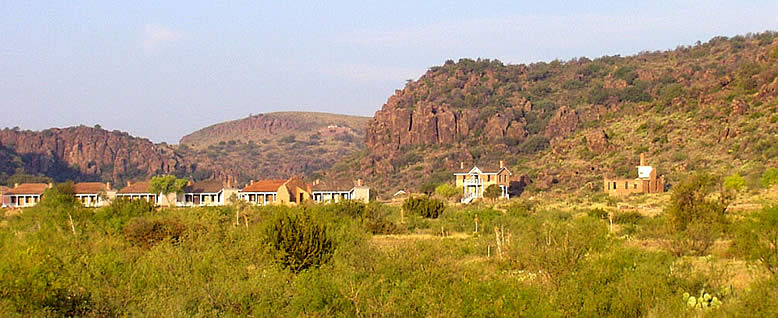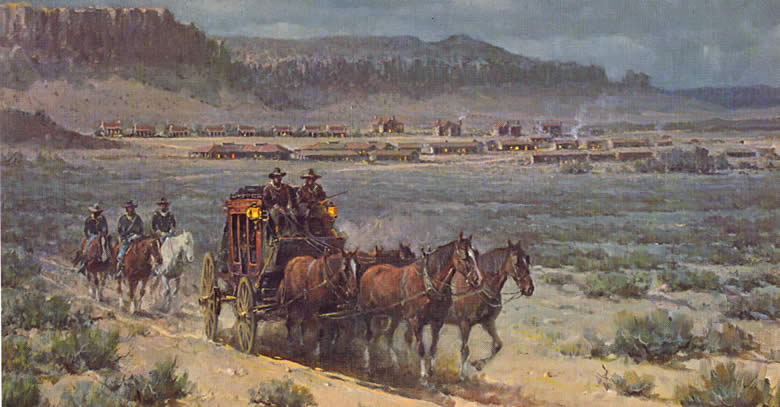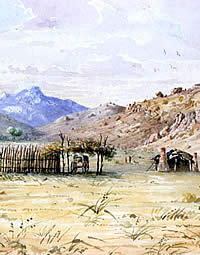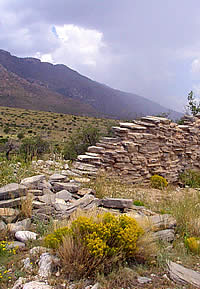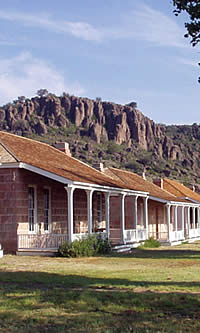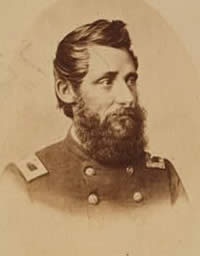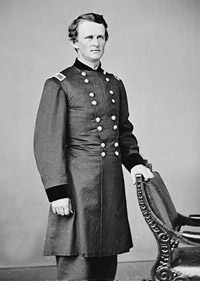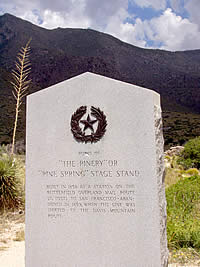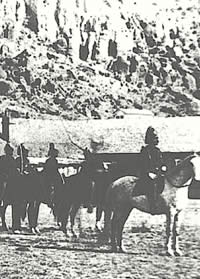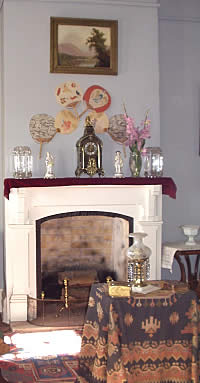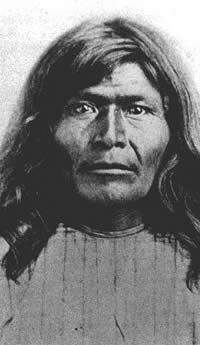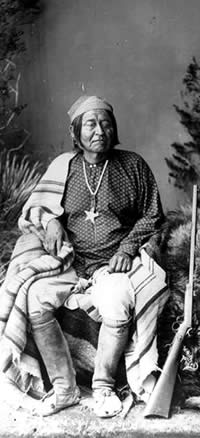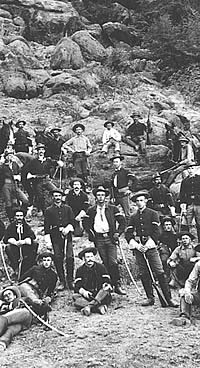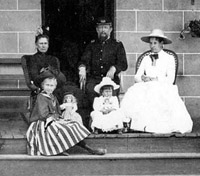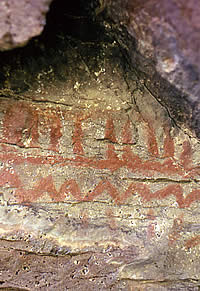
Indian pictographs in Limpia Canyon,
Davis Mountains. Although soldiers at Fort Davis observed
aboriginal drawings on the trunks of cottonwood trees
along Limpia Creek, paintings such as the one above
were rendered on canyon walls and in rockshelters, a
natural canvas for artists. The name given an early
Army encampment in the canyon, "Painted Comanche
Camp," no doubt derived from such artwork. Photo
from TARL Archives (JD7, #C-2).
|
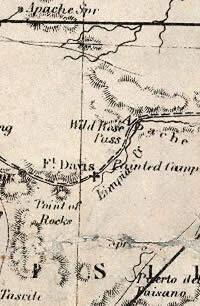
As shown on this 1861 map, Fort Davis
was sited on Limpia Creek near the mouth of Wild Rose
Pass. Note reference to Painted Camp just east of the
post. Inset of Richardson's New Map of the State of
Texas, courtesy the David Rumsey Map Collection.
|
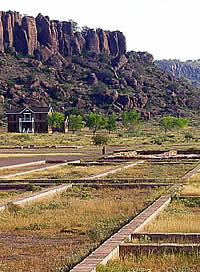
Low foundation footings are all that
remain of some of the enlisted men's barracks constructed
in the mid 1870s. In the distance is a two-story shared
officers' quarters, with the foundations of the post
headquarters building on left. Photo by Susan Dial.
|
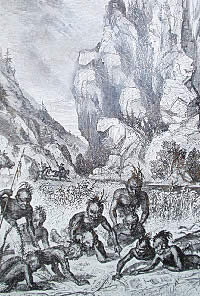
"Indians Surprised in Limpia
Canyon" reads the title of this intriguing drawing
from the published accounts of a Butterfield stage traveler
in the 1850s. Following an attack on the Jackass Mail,
Indians discovered a packet of illustrated newspapers,
which they reportedly found absorbing. The sudden appearance
of soldiers on the scene led the Indians to ascribe
magical powers to the newspapers. Drawing courtesy National
Park Service: Fort Davis National Historic Site, Texas.
|
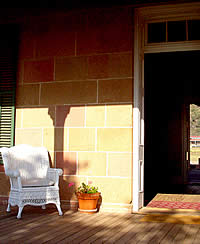
Morning sun streams over a wide porch
in front of the Commanding Officer's Quarters. Photo by Susan Dial.
|
|
The Davis Mountains are an almost lush, alpine
oasis rising from the surrounding desert. Nearly out of view
from modern Interstate Highway 10, these peaks may escape
the notice of westbound travelers impatient to reach El Paso,
200 miles away. But the U.S. Army engineers who passed through
the Trans-Pecos in 1849 took careful note of what they found
here.
Lieutenants W.H.C. Whiting and William F. Smith had been sent
from San Antonio to find a practicable wagon route west. After
several days spent looking for drinkable water west of the
Pecos River, Whiting must have felt a great sense of relief
upon finding a small stream in a mountain canyon. His reaction
to the discovery was almost lyrical: he named the little brook
the "Limpia," while a two-mile passage among the
mountains became "Wild Rose Pass." His party's resting
place was "Painted Comanche Camp," so named because
of pictographs that adorned nearby cottonwood trees.
Whiting and Smith ultimately recommended that the army build
a road through the pass, in what would be known for a time
as the Limpia Mountains. It became the army's preferred route
through the Trans-Pecos, and hundreds of emigrants bound for
the California gold fields were soon traveling it. In 1851,
frontiersman Henry Skillman began using the road for his mail
service between San Antonio and Santa Fe.
Travel in the Trans-Pecos was dangerous. Mescalero
Apaches inhabited the mountains through which the road passed.
Comanche and Kiowa raiders sweeping down from the High Plains
crossed the road on their way to their favorite raiding targets
in northern Mexico. By mid-1854, it was plain that the army
needed posts to protect the route.
General Persifor F. Smith, departmental commander,
set out from San Antonio in September to look into the problem
and find a site for a post. Smith stopped at the Painted Comanche
Camp, where he was joined by Lieutenant Colonel Washington
Seawell and the six companies of the 8th Infantry that would
garrison the new installation. It was to be called Fort Davis,
in honor of the United States secretary of war, Jefferson
Davis. General Smith personally selected the location for
the fort, a spot about a quarter of a mile from the camp,
surrounded on three sides by the sheer rock cliffs of a canyon.
A stand of timber was found in the mountains
about 25 miles from away, and Sewell soon had the soldiers
hauling logs and cutting planks for living quarters and other
buildings. Six shelters, one for each company, were erected
across the mouth of the canyon. They were made of oak and
cottonwood pickets and measured 20 feet wide and 56 feet long.
Within two years, these were converted to kitchens
and mess rooms. New stone barracks with thatched roofs were
erected to the east, in a line parallel with the original
structures. Other stone buildings were a bakehouse, blacksmith
shop, and warehouse. Additional structures were built further
up the canyon to the west. These were made of wood planks,
set into the earth on end, picket style, with plank or earthen
floors and thatched grass or canvas roofs. They included 11
sets of officers' quarters and a two-room house for the commanding
officer. A hospital, adjutant's office, housing for married
soldiers and their families, storehouses, a stable, a sawmill,
and a sutler's store made Fort Davis one of the army's most
extensive western posts.
The San Antonio-El Paso mail enterprise was
being reorganized even as General Smith was issuing his order
for establishment of Fort Davis. Skillman and George Giddings
entered into a partnership to provide mail and passenger service,
and constructed "La Limpia Station" a mile from
the army encampment. This provided the stage drivers a place
to obtain a fresh team of mules, the line's first relief station
west of the Pecos River.
Additional stations were established at Live
Oak Creek, where the army placed Fort Lancaster in 1855; in
Quitman Canyon, where Fort Quitman was established in 1858;
and at Comanche Springs, where the army began erecting Fort
Stockton in 1859. Intermediate stations were built between
the various army posts throughout the 1850s.
The availability of replacement mules made
it possible for the coaches to travel the road more quickly
and more frequently, but the relief stations and their corrals
also were magnets for Apaches and Comanches. The army could
provide little protection, and Skillman and Giddings experienced
a disastrous year in 1858. In January, La Limpia was raided
and all its stock was stolen, and the El Muerto and Van Horn's
Wells stations were both destroyed. Raids on Comanche Springs
and Lancaster, and another on La Limpia, followed during the
spring. The stations at Escondido Springs and Eagle Springs
were destroyed in the fall. In 1859, the Trans-Pecos stations
suffered 10 more similar attacks.
|
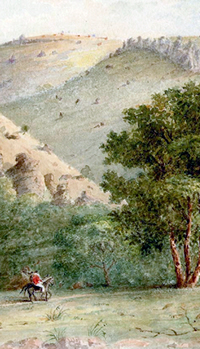
The beauty of a two-mile passageway
through the Limpia mountains inspired Army road engineer
Lt. W.H.C. Whiting to name it Wild Rose Pass. The scene
above was painted by Capt. Arthur T. Lee, another admirer
of the area's scenery. Click to see full image. "In
Wild Rose Pass," courtesy of the Rochester Historical
Society.
Click images to enlarge
|
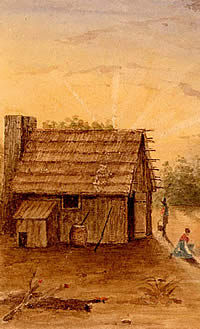
The first buildings at the fort were
constructed of wood, using timber hauled from as far
as 25 miles away. When more permanent structures of
stone were built two years later, the earlier, crude
buildings were converted to kitchens and mess rooms.
"In Maggie's Kitchen," by Capt. Arthur T.
Lee, courtesy of the Rochester Historical Society.
|
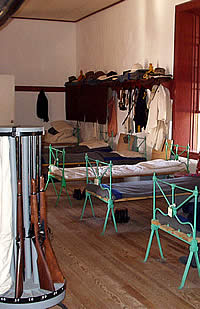
With bunks made up and cavalry carbines
stacked, this enlisted men's barracks appears much like
it would have in the past. It was among the first buildings
to be constructed after the Army reestablished Fort
Davis in the late 1860s. Photo by Susan Dial.
|
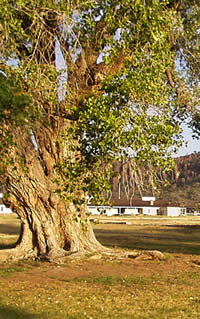
Cottonwoods flank a distant view
of the fort. The white buildings on left are enlisted
men's barracks, beyond them, officers' row. Photo by Susan Dial.
|
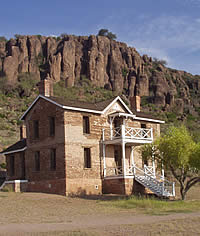
Constructed at the base of a rugged
cliff in 1885, this two-story shared quarters was often
occupied by junior officers. Photo by Susan Dial.
|
|
